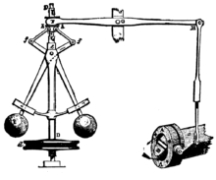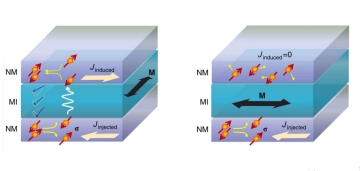We all know that the earth, like many spherical bodies, turns on its axis. It is said to have angular momentum. The spin velocity does not change, slow down or speed up, unless force or friction is applied.

This principle is illustrated by that wonderful nineteenth-century mechanism, the centrifugal fly-ball governor, used to regulate precisely a steam engine’s speed of rotation. Any change in angular momentum will allow the weighted spheres to move upward or downward toward the center of the earth, making for change in RPM. Linkage to a steam intake valve adjusts engine torque so that speed is regulated.
All of this is in accord with Newtonian physics. But in the quantum realm, the situation with regard to spin is altogether different. A simplistic notion would be to conceive of elementary particles as rotating about their axes much like astronomical bodies such as the earth. This is true in that the mathematical laws that are applicable to quantized angular momentum are valid. But there are differences between these phenomena. The direction of an elementary particle’s spin can be changed, but the speed of rotation for any given elementary particle is fixed, and that is what determines the quantum number. Depending on the type of particle, the quantum number may be expressed as half-integer values.
Bosons have integer spins, such as 0, 1 and 2. Fermions have half-integer spins, such as 1/2, 3/2 and 5/2. Fermions conform to the Pauli exclusion principle. Bosons do not, meaning that two bosons may have the same time and space co-ordinates.
By definition, true elementary particles such as the electron cannot be further subdivided. Accordingly, spin must be seen as an intrinsically basic physical property, in the same category as mass and charge. But whereas mass and charge accrete when elementary particle join to work in concert, spin is quite different. The spin of a composite particle, such as a helium atom, is different from that of the elementary particles from which it is formed. A helium atom can have an integer spin 0, becoming in effect a boson, despite the fact that its components, electrons and quarks, have half-integer spins and thus are fermions.
Researchers are exploiting the spin of electrons to create what are called spintronic devices. These electronic components are potentially more energy efficient and more versatile than those comprised of silicon chips and circuit elements.
In many materials, electron spins are equally present in both the up and the down state. A spintronic device requires generation or manipulation of a spin-polarized population of electrons, so there are more spin-up or spin-down electrons. A net spin polarization typically comes by putting a material in a large magnetic field. Spin lifetimes of conduction electrons in metals are relatively short (typically less than a nanosecond). An important research area is devoted to extending this lifetime to technologically relevant timescales.
The simplest method of generating a spin-polarised current in a metal is to pass the current through a ferromagnetic material. In one case, researchers at the University of Calif. at Riverside described a tri-layer, sandwich-like, structure that serves as a scalable pure spin current device, an essential ingredient in spintronics.

In the structures used by the researchers, there are two metals and a magnetic insulator in between. The metals are for spin current generation and detection (conversion of spin current back to charge current) via the so-called spin Hall effect and inverse spin Hall effect.
The magnetic insulator is an electrical insulator but a good spin current conductor. The spin current flowing in the insulator does not involve mobile electrons so it does not dissipate energy as an electrical current does in joule heating.
The researchers have also demonstrated that the electrical signal transmission through the magnetic insulators can be switched on and off depending on the magnetic state, or direction of the magnetization, of the magnetic insulators.
So the direction of the magnetization can be regarded as a memory state of non-volatile random access memory devices. In addition, the signal level can be modulated by changing the direction of the magnetization. The sandwich structure can be made small by nanofabrication so the devices can be scaled down.
The authors of the paper described their work in the journal Nature Communications. Their paper is called “Observation of magnon-mediated current drag in Pt/yttrium iron garnet/Pt(Ta) trilayers.“

Leave a Reply
You must be logged in to post a comment.